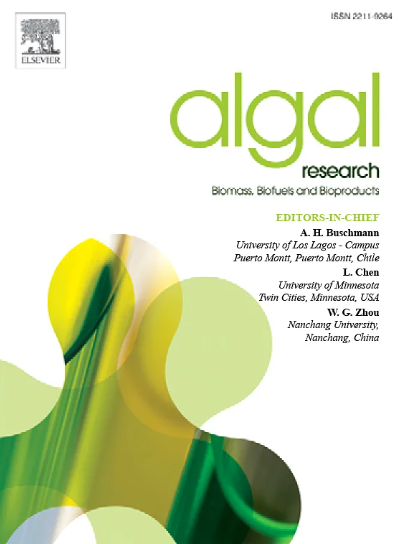Assessment of different nitrogen sources and bioreactor cultivation strategies during growth of Aurantiochytrium limacinum on spruce sugars
IF 4.6
2区 生物学
Q1 BIOTECHNOLOGY & APPLIED MICROBIOLOGY
Algal Research-Biomass Biofuels and Bioproducts
Pub Date : 2025-02-06
DOI:10.1016/j.algal.2025.103951
引用次数: 0
Abstract
Heterotrophic microbial production of omega-3 fatty acids for feed and food applications is an attractive alternative to the use of fish oils. In this study we have converted enzymatic hydrolysates of wood to oils rich in DHA by applying Aurantiochytrium limacinum SR21 in controlled bioreactor fermentation processes. FTIR was used as a rapid method to evaluate the effects of dissolved oxygen (DO), C/N ratios, and nitrogen sources on protein-to-lipid ratios in the produced microbial biomass. A biomass concentration of 21.7 g/L containing 29.1 % total fatty acid (TFA), out of which 35.1 % was docosahexaenoic acid (DHA), was obtained in batch cultivations using 20 % DO, a medium C/N ratio of 10gC/gN and a 50: 50 blend of complex organic nitrogen, in the form of yeast extract and peptone, and NaNO3. A continuous cultivation strategy (D = 0.3 day−1) led to much lower biomass and lipid titers compared to a batch process, indicating that a single vessel chemostat set-up may not be suitable for lipid production by A. limacinum SR21.
求助全文
约1分钟内获得全文
求助全文
来源期刊

Algal Research-Biomass Biofuels and Bioproducts
BIOTECHNOLOGY & APPLIED MICROBIOLOGY-
CiteScore
9.40
自引率
7.80%
发文量
332
期刊介绍:
Algal Research is an international phycology journal covering all areas of emerging technologies in algae biology, biomass production, cultivation, harvesting, extraction, bioproducts, biorefinery, engineering, and econometrics. Algae is defined to include cyanobacteria, microalgae, and protists and symbionts of interest in biotechnology. The journal publishes original research and reviews for the following scope: algal biology, including but not exclusive to: phylogeny, biodiversity, molecular traits, metabolic regulation, and genetic engineering, algal cultivation, e.g. phototrophic systems, heterotrophic systems, and mixotrophic systems, algal harvesting and extraction systems, biotechnology to convert algal biomass and components into biofuels and bioproducts, e.g., nutraceuticals, pharmaceuticals, animal feed, plastics, etc. algal products and their economic assessment
 求助内容:
求助内容: 应助结果提醒方式:
应助结果提醒方式:


